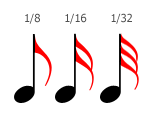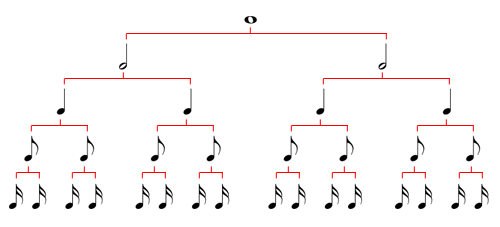Note duration is a fundamental aspect of reading and playing music. It tells us how long a note should be held or played, and it is visually represented in sheet music by different types of note symbols. Learning to recognize and interpret these symbols is key to mastering rhythm and timing in music.
The Basics of Note Duration
On sheet music, notes come in various forms, each representing a specific length of time for which the note should be held. Let’s start by looking at some of the most common note types.

In the image above, you’ll see five types of notes arranged from longest to shortest duration:
- Whole Note (Semibreve): The longest note in common use. It lasts for the full length of four beats in a 4/4 time signature.
- Half Note (Minim): This note lasts for two beats, or half the duration of a whole note.
- Quarter Note (Crotchet): Commonly used, the quarter note lasts for one beat, or half the duration of a half note.
- Eighth Note (Quaver): This note lasts for half a beat, or half the duration of a quarter note.
- Sixteenth Note (Semiquaver): Lasting for a quarter of a beat, this note is half the duration of an eighth note.
The relationship between these notes is simple: each note has half the duration of the note to its left. For example, two half notes fit into the duration of a single whole note, and two quarter notes fit into the duration of a half note.
Visualizing Note Duration
One way to think about note duration is to visualize it as a division of time. If a whole note occupies the entire span of time in a measure (in common 4/4 time), then half notes divide that time in half, quarter notes divide it further, and so on. This division continues as you work with smaller note values like eighth, sixteenth, or even sixty-fourth notes.
To clarify:
- One whole note = Two half notes
- One half note = Two quarter notes
- One quarter note = Two eighth notes
- One eighth note = Two sixteenth notes
This mathematical relationship helps musicians understand how long to hold each note and how to group them within measures.
Flags: A Closer Look at Shorter Notes

When you see smaller notes, such as eighth notes or sixteenth notes, you’ll notice flags attached to their stems. These flags visually indicate that the note’s duration is shorter than a quarter note. Each flag halves the duration of the note. For instance:
- A single flag on a note stem represents an eighth note (half the duration of a quarter note).
- Two flags on a note stem represent a sixteenth note (half the duration of an eighth note).
The concept of flags continues indefinitely—though less commonly used, notes can have three, four, or more flags. For example, a note with three flags is called a thirty-second note (lasting 1/32 of a whole note), and a note with four flags is called a sixty-fourth note (lasting 1/64 of a whole note).
Pro Tip💡
When notes with flags are connected to one another (e.g., in eighth or sixteenth note groupings), the flags are often replaced with beams connecting the notes, making them easier to read.
Note Duration Relationships
Here’s a quick overview of the relationship between different note durations:

In this visual, you can see how each note fits into the others. Understanding these relationships helps musicians break down complex rhythms into more manageable components, whether they are reading sheet music or composing their own.
Alternative Naming Conventions
In addition to understanding note durations, it’s useful to be aware that different parts of the world use alternative names for these notes. While the American system refers to notes as whole notes, half notes, quarter notes, etc., the British system uses different terms:
| Notation | US | UK |
 | Octuple whole note | Maxima |
 | Quadruple whole note | Longa |
 | Double whole note | Breve |
 | Whole note | Semibreve |
 | Half note | Minim |
 | Quarter note | Crotchet |
 | Eighth note | Quaver |
 | Sixteenth note | Semiquaver |
 | Thirty-second note | Demisemiquaver |
 | Sixty-fourth note | Hemidemisemiquaver |
 | Hundred twenty-eighth note | Quasihemidemisemiquaver semihemidemisemiquaver |
 | Two hundred fifty-sixth note | Demisemihemidemisemiquaver |
While the names may vary, the actual duration of the notes remains the same. So whether you’re playing a quarter note in the U.S. or a crotchet in the U.K., the note represents the same rhythmic value.
Understanding Note Durations in Context
The duration of notes is always contextual and depends on the time signature of the piece. For example, in a 4/4 time signature, the whole note receives four beats, while the quarter note gets one beat. In a 3/4 time signature, the quarter note still receives one beat, but there are only three beats per measure, affecting how notes are grouped and played.
Pro Tip: When learning a new piece of music, it’s important to first check the time signature, as this will help you understand how long each note lasts and how the rhythms are structured.
Conclusion: Mastering Note Duration
Understanding note duration is crucial for reading and performing music accurately. Whether you’re playing a whole note that sustains for four beats or a series of rapid sixteenth notes, recognizing the note symbols and their respective durations will help you maintain proper timing and rhythm.
By mastering these fundamental concepts, you’ll be better equipped to tackle more complex rhythms and pieces, ultimately becoming a more proficient and confident musician. Remember, it’s not just about playing the right notes—it’s about playing them for the right amount of time.
- Want to improve your guitar playing?
-
These lessons have been written by me, a guitar enthuthiast. I've written them to the best of my abilities, but I'm no guitar teacher!
If you want award-winning, well structured but inexpensive lessons, I strongly recommend you check out Guitar Tricks. They have great range of video guitar lessons from numerous coaches specialising in a wide range of styles.
I've seen their videos, and they're great. With these guys, I'm confident you'll be improving in no time!
